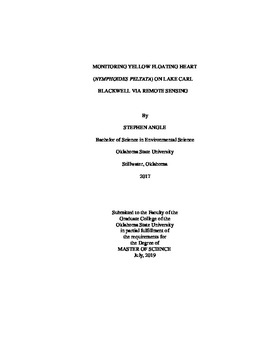| dc.contributor.advisor | Stoodley, Scott | |
| dc.contributor.author | Angle, Stephen | |
| dc.date.accessioned | 2020-01-30T19:46:36Z | |
| dc.date.available | 2020-01-30T19:46:36Z | |
| dc.date.issued | 2019-07 | |
| dc.identifier.uri | https://hdl.handle.net/11244/323390 | |
| dc.description.abstract | Yellow floating heart (Nymphoides peltata) is an invasive floating-leaf aquatic plant. This species forms dense mats of rhizomatous vegetation that can produce tens of thousands of seeds per square meter. These seeds spread via hydrochory and establish additional colonies. Fragmentation of N. peltata from disturbances further increases its spatial extent, as detached plant material forms new colonies. N. peltata successfully colonized over 40 acres on Lake Carl Blackwell, in Stillwater, Oklahoma. The herbicide glyphosate was applied on 10 dates in 2018 to combat further spread of N. peltata. To evaluate the efficacy of these spraying events, a DJI Phantom 4 Unmanned Aerial Vehicle (UAV) was used to image the spatial extent of N. peltata coverage of infested coves on five dates over the 2018 growing season. These images were used to create orthomosaics and subsequently analyzed to examine temporal changes in plant coverage spatial extent in response to glyphosate treatment. Near infrared (NIR) images from the Sentinel-2 satellite were also used to evaluate plant health based on Normalized Difference Vegetation Index (NDVI). A pilot study evaluated the spatial extent and NDVI changes of one infested cove on the north side of Lake Carl Blackwell. This study includes and is an expansion of that pilot study where five additional coves were analyzed, and comparisons were made between UAV and Sentinel-2 NDVI results at different NDVI thresholds for plant health (0.33, 0.365, and 0.4). A brief project cost comparison between monitoring methods is included. Results show limited success with glyphosate application, as N. peltata maintains a strong presence in five of the six study coves. This study presents an effective methodology for monitoring plant stress temporally using UAV and satellite remote sensing. | |
| dc.format | application/pdf | |
| dc.language | en_US | |
| dc.rights | Copyright is held by the author who has granted the Oklahoma State University Library the non-exclusive right to share this material in its institutional repository. Contact Digital Library Services at lib-dls@okstate.edu or 405-744-9161 for the permission policy on the use, reproduction or distribution of this material. | |
| dc.title | Monitoring Yellow Floating Heart (Nymphoides peltata) on Lake Carl Blackwell via Remote Sensing | |
| dc.contributor.committeeMember | Dzialowski, Andy | |
| dc.contributor.committeeMember | Jacob, Jamey | |
| osu.filename | Angle_okstate_0664M_16436.pdf | |
| osu.accesstype | Open Access | |
| dc.type.genre | Thesis | |
| dc.type.material | Text | |
| dc.subject.keywords | invasive | |
| dc.subject.keywords | remote sensing | |
| dc.subject.keywords | yellow floating heart | |
| thesis.degree.discipline | Environmental Science | |
| thesis.degree.grantor | Oklahoma State University | |
